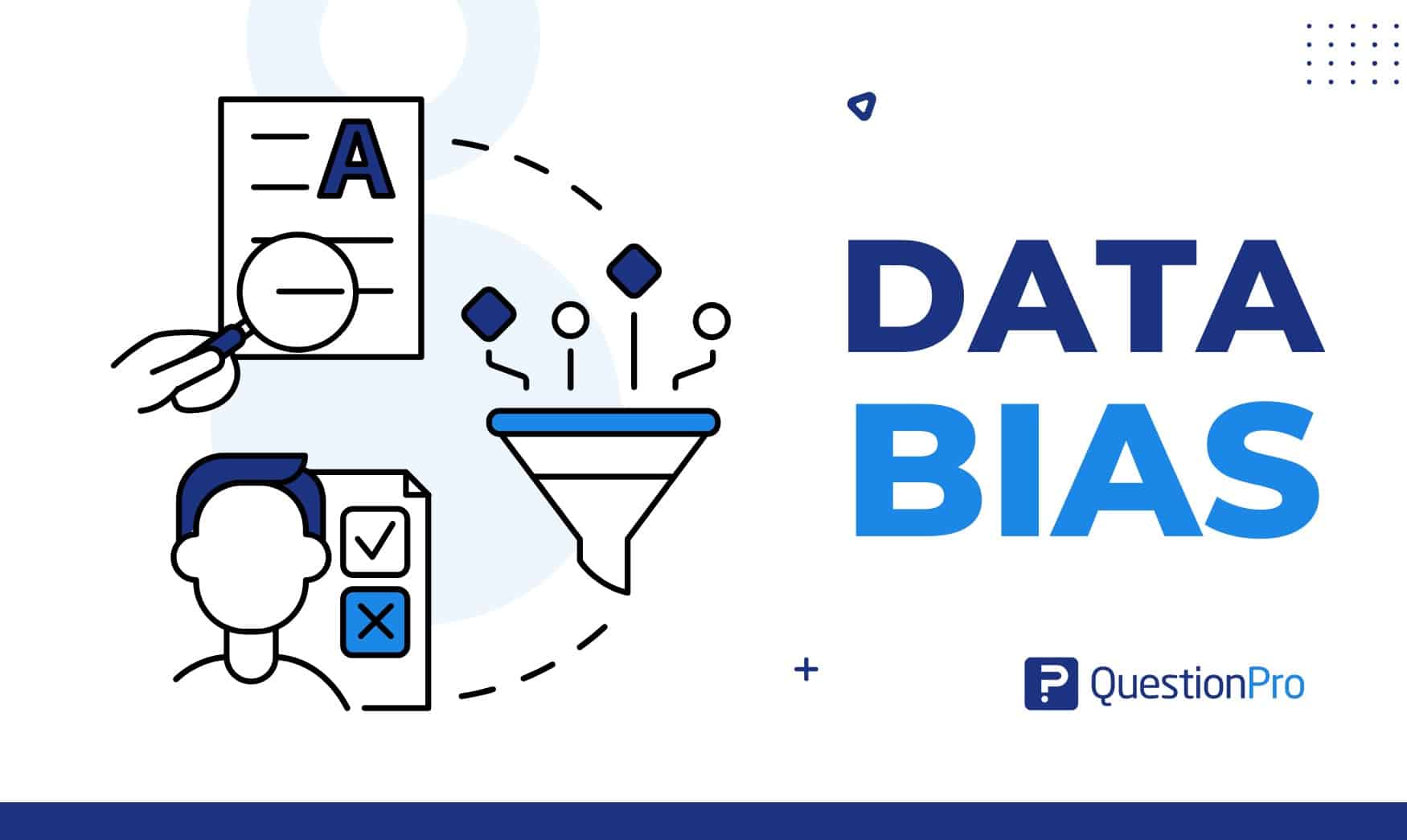
Data is important to businesses of all sizes. Businesses use data to better understand their customers, develop new products, and respond to the market. Data bias affects the collection, analysis, and interpretation of data.
To use data fairly, it’s crucial to understand data bias. Identifying and avoiding common types of data biases is an important step in effectively employing data. So, let’s start with learning what data bias is.
What is Data Bias?
Data bias refers to the presence of systematic errors in a dataset. It can lead to incorrect or unfair predictions when using that data for analysis, machine learning, or decision-making. Therefore, it is crucial to identify and avoid them promptly.
Data biases are similar to human biases, like assuming things based on gender or discriminating based on race. Machines pick up on these biases because they learn from the data, mainly from people. These biases can be problematic, leading to predictions that are not accurate and have no value in areas like science, finance, and economics.
Additionally, data biases can worsen existing social inequalities, making societal problems more challenging and slowing down efforts to make things fair and inclusive.
Different Types of Data Bias
Data bias can significantly impact the accuracy and fairness of an analysis, machine learning model, and decision-making process. Understanding the various data bias types is essential for recognizing, addressing, and mitigating these biases in diverse datasets.
Here are some of the most common types of data bias:
Response Bias
Response bias occurs when the participants in a study provide incorrect or misleading information.
For example, in a survey about healthy eating habits, respondents may overstate how healthy their diet is to make themselves look good.
Selection Bias
Selection bias occurs when the chosen group for a study is not picked properly or suitably.
For example, if a job satisfaction survey is done only with employees who willingly decide to take part, leaving out those with strong opinions who chose not to participate, it creates selection bias.
Sampling Bias
Sampling bias happens when the method of selecting participants introduces a systematic error. This makes the sample unrepresentative of the population.
For example, if a political poll is only conducted through online surveys, it might leave people without internet access, resulting in biased political opinions.
Confirmation Bias
Confirmation bias happens when you prefer information that supports your existing beliefs or values.
In research, this bias can result in selectively recognizing data that agrees with one’s hypotheses while ignoring conflicting evidence.
Algorithmic Bias
Algorithmic bias happens when machine learning algorithms show unfair behavior, usually mirroring the biases found in the data they were trained on.
For instance, a facial recognition system trained mostly on pictures of people with light skin may have difficulty correctly recognizing faces with darker skin tones.
Group Attribution Bias
Group bias happens when information is used consistently by both individuals and groups, assuming that their behavior and characteristics are identical.
For example, assuming that everyone from a specific nationality has the same cultural traits can lead to stereotypes and unfair judgments.
Reporting Bias
Reporting bias happens when there’s a difference between what a study finds and what gets reported.
For example, in clinical trials, researchers might decide not to share negative results, which can make treatment seem more effective than it actually is.
Omitted Variable Bias
Omitted variable bias occurs when an important factor that affects the connection between the independent and dependent variables is not included in the study.
For example, if you examine how education affects income but don’t consider work experience, your conclusion may be incomplete and biased.
Data Bias in Machine Learning and Artificial Intelligence
Data bias occurs in machine learning and artificial intelligence when mistakes or unfair preferences exist in the data or algorithms used to teach models. These biases can cause results to be unbalanced, lead to unfair treatment, and make predictions less accurate.
Recognizing and fixing biases in machine learning is essential. This means ensuring the training data is good, using fair and transparent algorithms, and regularly checking models for unintended biases.
The various types of data bias in machine learning are critical considerations for building fair and ethically sound AI projects. Understanding these biases is essential for identifying and rectifying issues before they impact the integrity and accuracy of ML models.
01. Systemic Biases
- These biases are usually hidden in societal structures, making them hard to identify.
- It occurs when some social groups are treated better than others. For example, if disabled people are not well-represented in studies, the infrastructure may not be adjusted to meet their needs.
02. Automation Data Bias
- This occurs when we trust AI recommendations without checking if they’re accurate.
- Relying too much on automated systems can result in less effective decision-making.
04. Overfitting and Underfitting
- Overfitting occurs when a model learns too much from irrelevant details in the training data, and underfitting happens when a model is too basic.
- Overfitting makes a model perform poorly on new data while underfitting shows that the model struggles to understand the main patterns in the data.
- Both overfitting and underfitting affect the model’s accuracy in predicting new data.
05. Implicit Data Bias or Overgeneralization Bias
- Implicit biases occur when you mistakenly use assumptions from one set of data for all future data sets.
- Thinking that the patterns you see in one information set will always be true for everything.
- Overgeneralization can lead to wrong predictions when used on different or unknown data sets.
It’s crucial to grasp and deal with data bias to create AI systems that are fair, transparent, and free from discriminatory results. It requires carefully collecting data, designing unbiased algorithms, and continuously checking to reduce biases in machine learning models.
Data Bias in Synthetic Data
Data bias in synthetic data is a significant concern that has gained attention as the use of artificial intelligence (AI) and machine learning (ML) continues to grow. It’s important to acknowledge that synthetic data generation is challenging, and biases can still emerge.
Understanding and addressing these issues is crucial for deploying synthetic datasets in machine learning applications.
- Raw Real Data Quality: The quality of synthetic data depends on the quality of the original real data used. If the initial data has biases or inaccuracies, synthetic data may unintentionally inherit and continue these biases.
- Control and Correction: Synthetic data offers control over generated output, but it must be used responsibly. While it allows for a more balanced dataset, a sophisticated generator is needed to identify errors in real data and suggest corrections.
- Complementing Biased Real Data: Synthetic data can supplement biased real datasets when challenges like limited data availability, high costs, or lack of consent create biases. It helps diversify the dataset, reducing reliance on potentially biased real data.
- Addressing Imbalances: Synthetic data is useful when the original dataset is imbalanced, with certain groups being overrepresented. Generating synthetic samples helps create a more equitable distribution, promoting fairness and inclusivity in machine learning models.
- Transparency and Bias Reduction: While synthetic data can offer insights, reducing bias in the original dataset is crucial. Proper labeling, thorough cleaning, and incorporating bias testing during development are essential to minimize bias risks in both real and synthetic data.
If you want to learn more, read this blog: 11 Best Synthetic Data Generation Tools in 2024
How to Identify Data Bias?
Identifying data bias is crucial for maintaining the integrity and reliability of analyses and decision-making processes. Employing effective methods can uncover biased data that may otherwise go unnoticed. Two key approaches for identifying data bias include:
Checking the Data Source
- Examine the Data Generation Process: Understand how the data was generated and whether any verification processes were implemented during collection.
- Evaluate System Efficiency: Assess the efficiency and reliability of the system responsible for data collection. Investigate whether there are any inherent biases in the data collection process.
- Ask Critical Questions: Pose questions regarding the data collection methodology to gain insights into potential biases. For instance, consider whether the sample is representative of the entire population or if certain groups are underrepresented.
Check for Unusual Data
- Look for Differences: Make graphs or visuals to find unusual patterns in the data.
- Investigate Reasons: If you see any unusual data points, figure out why they’re there. Check if they are real or if they suggest a problem.
- Confirm Accuracy: Make sure the unusual data is correct by checking it against other sources or doing more analysis.
- Check for Missing Variables: See if any information is missing or incomplete in the data. This could introduce bias, so explore the data further to understand potential issues.
How to Avoid Data Bias?
Data bias is a big problem in different parts of the business. It affects decision-making and the creation of machine-learning programs. Business leaders need to actively work to reduce bias at each step of the data process. Here are important ways to prevent data bias:
Continuous Evaluation and Awareness
Business leaders need to regularly check if the data they use accurately represents the situation. This includes:
- Carefully looking at internal surveys.
- Thinking about using machine learning.
- Reviewing how statistics are used in marketing materials.
Make sure that teams know about possible biases and are watchful in finding and fixing them. Giving training on spotting and reducing bias can improve the organization’s overall understanding of data.
Finding Alternatives and Reducing Human Biases
- Explore Different Datasets: Actively look for alternative datasets that serve the same purpose but are less biased. Using a variety of data sources helps avoid depending too much on one biased dataset.
- Reduce Human Biases: Understand that machine learning copies human ideas and biases. To lessen biases when gathering data, consciously collect a diverse and representative set of data.
Benchmarking and Resampling
Use benchmarks to measure biases in algorithms. When paired with benchmarks, algorithms can automatically find and emphasize potential biases, giving useful information about areas that need fixing.
Use resampling techniques to make sure the data is fair. Although resampling can use a lot of resources, it’s a useful way to get unbiased datasets. But it’s important to think carefully about the costs and time involved.
Identifying and Correcting Bias
- Understanding Data Generation: To prevent bias, start by fully grasping how the data was created. By mapping out the data generation process, you can identify biases and take proactive steps to address them.
- Exploratory Data Analysis (EDA): Conduct a thorough EDA to identify patterns and potential biases within the dataset. EDA techniques provide valuable insights into the data’s nature and help create effective strategies to minimize bias.
- Debiasing Techniques: Addressing societal bias and biases in human-generated content requires specialized debiasing techniques. These can include pre-processing, in-processing, or post-processing approaches customized to the specific dataset and application.
Role of QuestionPro in Mitigating Data Bias
QuestionPro is a comprehensive platform for surveys and research. Users can easily create, distribute, and analyze surveys and feedback forms. It offers many features and tools to make the survey process smoother.
Here are some ways you can mitigate biases by using QuestionPro:
- Diverse Question Types: QuestionPro allows users to use various question types, like multiple-choice, open-ended, and rating scales. This helps collect diverse responses and lowers the risk of bias from limited options.
- Randomization: QuestionPro allows randomizing answer choices to prevent order bias. This ensures participants see choices in a different sequence, reducing the impact of question order on responses.
- Demographic Filtering: Users can use demographic filters to segment and analyze data based on participant characteristics. This helps understand response variations across different groups, ensuring a more comprehensive analysis.
- Branching or Skip Logic: QuestionPro supports branching or skip logic, allowing for dynamic content based on previous responses. This can help customize questions to individual respondents, creating a more personalized and relevant survey experience.
- Anonymous Surveys: Conducting anonymous surveys can encourage more honest and unbiased responses, as participants may feel more comfortable sharing their opinions without fear of identification.
- Data Validation and Quality Checks: QuestionPro provides tools for data validation to identify and address inconsistent or inaccurate responses, maintaining the quality and reliability of collected data.
- Machine Learning and Analytics: Utilizing machine learning algorithms and advanced analytics within QuestionPro can help identify patterns and potential biases in the data. This allows researchers to address bias during the analysis phase.
Weighting and Balancing Data in QuestionPro: Minimizing Data Bias
Weighting and balancing data is an important method in survey research. Its purpose is to address sample bias and ensure that survey responses accurately represent the target audience. The “Weighting and Balancing” feature in QuestionPro Survey Platform helps users make survey data more accurate by adjusting it.
For example, if a business mostly serves males (80% of customers), but a survey shows a 50% male and 50% female response, there’s bias. With the “Weighting and Balancing” feature, users can fix this by giving different weights to responses.
The Role of Weighting and Balancing
Once sample bias is identified, the next step is implementing weighting and balancing techniques. These adjustments help remove bias and ensure the survey results match the real demographics of the intended audience.
In the example mentioned earlier, the survey responses would be weighted to give more significance to the male responses, ensuring a representation that aligns with the business’s customer base.
All types of businesses should examine potential bias in collecting, analyzing, and interpreting data. This helps businesses follow ethical data practices and improves the accuracy and representation of their data that reflects the real world.
QuestionPro’s “Weighting and Balancing” feature helps address data bias. It lets users adjust survey data to create a more accurate and representative dataset, leading to more meaningful insights.
Ready to experience? Take advantage of the QuestionPro free trial today!
FREE TRIAL LEARN MORE







